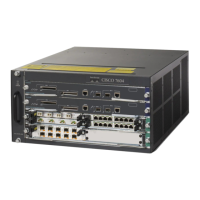Send document comments to nexus7k-docfeedback@cisco.com
3-12
Cisco Nexus 7000 Series NX-OS Interfaces Configuration Guide, Release 5.x
OL-23435-03
Chapter 3 Configuring Layer 2 Interfaces
Configuring Access and Trunk Interfaces
You can optimize the performance of access ports that are connected to end stations by simultaneously
setting that port as an access port. An access host port handles the STP like an edge port and immediately
moves to the forwarding state without passing through the blocking and learning states. Configuring an
interface as an access host port also disables port channeling on that interface.
Note See Chapter 6, “Configuring Port Channels,” for information on port-channel interfaces and the Cisco
Nexus 7000 Series NX-OS Layer 2 Switching Configuration Guide, Release 5.x. For complete
information on the Spanning Tree Protocol.
BEFORE YOU BEGIN
Ensure that you are configuring the correct interface to an interface that is an end station.
SUMMARY STEPS
1. configure terminal
2. interface type slot/port
3. switchport host
4. exit
5. (Optional) show interface
6. (Optional) copy running-config startup-config
DETAILED STEPS
Command Purpose
Step 1
configure terminal
Example:
switch# configure terminal
switch(config)#
Enters configuration mode.
Step 2
interface type slot/port
Example:
switch(config)# interface ethernet 3/1
switch(config-if)#
Specifies an interface to configure, and enters interface
configuration mode.
Step 3
switchport host
Example:
switch(config-if)# switchport host
Sets the interface to be an access host port, which
immediately moves to the spanning tree forwarding
state and disables port channeling on this interface.
Note Apply this command only to end stations.
Step 4
exit
Example:
switch(config-if)# exit
switch(config)#
Exits the interface mode.

